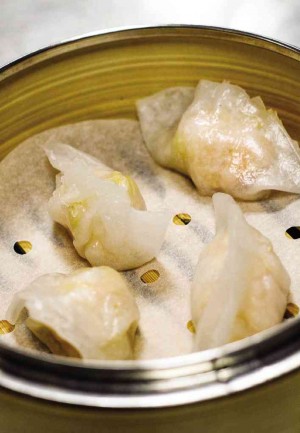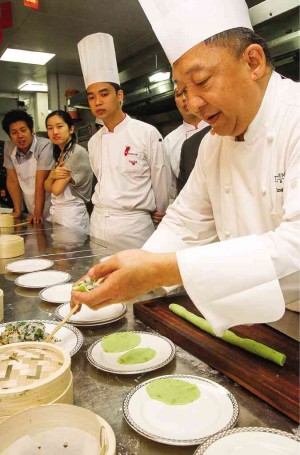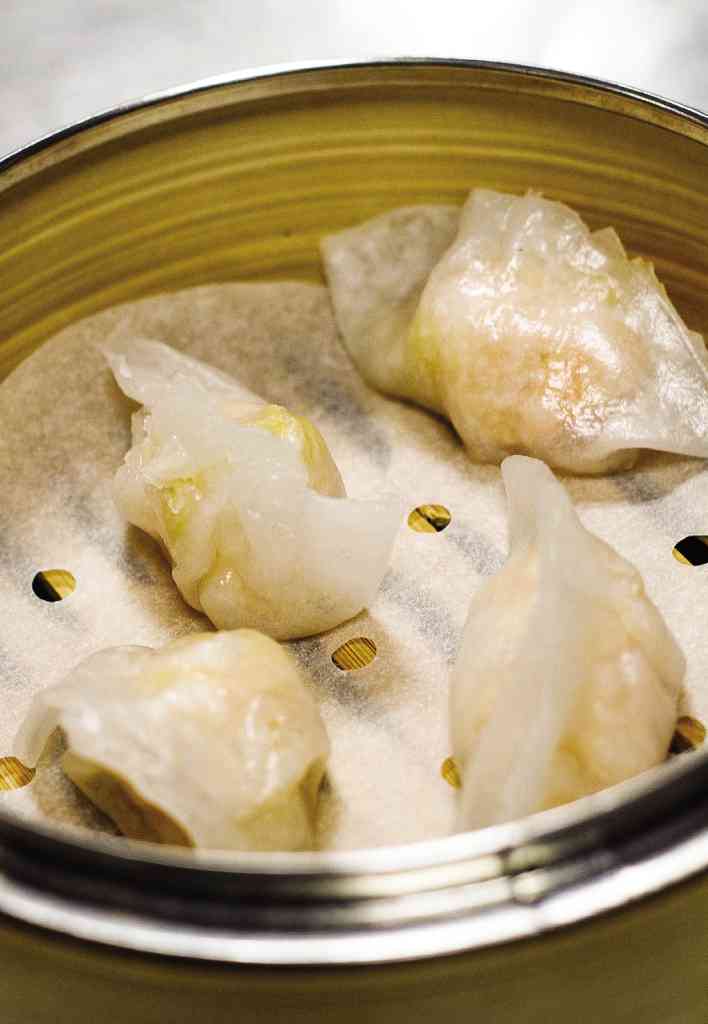
I’ll never look at dim sum the same way again. Not after attending a master class at the Peninsula Manila, conducted recently by the hotel’s own dim sum ambassador chef Yip Wing Wah.
Those morsels of food encased in translucent wrappers may look simple, but they’re really full of complexity, as our class of eager students realized while watching chef Yip transform flour into dough, then dough into wrappers.
Of course, having done this thousands of times in his decades-long career, chef Yip made it look so easy. But for us amateurs, it was far from that. It wasn’t just a matter of rolling the dough, but a matter of mastering a craft.
High-protein flour
First, Yip weighed equal parts of high-protein flour and cornstarch on an old-fashioned scale and carefully put each into separate piles. Then he poured boiling water into the flour and incorporated the cornstarch into the mixture. Before we knew it, he had a mound of pliable dough, from which he sliced a portion.
He then rolled this portion into a log. Using a cleaver, he chopped the log into about one-inch pieces. Each piece was rolled into a ball, each ball flattened into a disc. Then he put one side of the cleaver on top of a disc, and with the heel of his palm moved the cleaver clockwise and counterclockwise with the precision of a factory machine.
Using the edge of the cleaver, he swept the disc up with one deft motion and triumphantly held it up for all of us to see—the disc had become a perfectly round, paper-thin dim sum wrapper. As the TV chefs would say, how cool is that!
This being a master class, each of us was given a chance to roll and shape our own wrappers. With Yip and Teddy Leung, manager of Peninsula’s Chinese food and beverage operations, guiding us, each student was able to shape two wrappers. Not bad for beginners, but nothing compared to Yip’s sweeping motions that produced about one wrapper every five seconds.
About as challenging as making the wrapper was mastering the art of enclosing the filling. We had, first of all, to put just the exact amount of filling into each wrapper; otherwise the wrapper would burst.
Tricky technique
After folding the wrapper into a half-moon shape, we then had to pinch the front of the wrapper to create pleats or folds, while keeping the back of the wrapper flat—a really tricky technique.
I managed to create only six folds on my dim sum, a measly and clearly amateur effort. Leung said experts can create up to 16 folds.
After each student had wrapped three shrimp dumplings (har gaw) and three chive dumplings, we took a snack break while the kitchen staff steamed our dumplings on individually labeled bamboo steamers.
Dim sum, Leung said, actually means point (dim) to your heart (sum). In the olden days, the lives of the people in agricultural China revolved around the farm. The men would go to the fields to till the farm early in the morning and return home in the evening.
To show their love for their husbands, the women would make dumplings, which their husbands could take to the fields and eat in small bites. It was a delicious way indeed to express their love.
Though dim sum was originally eaten only in the daytime, nowadays it’s served at all hours of the day and night, Leung added. Dim sum is also the perfect accompaniment to tea. Otherwise drinking tea without eating anything could make one drunk.
Finally it was time for the moment of truth. We were each given back our bamboo steamers containing the dumplings that we managed to create.
Pleasant surprise
What a pleasant surprise. Though I thought my dumplings looked rather crude, now that they had been steamed, they looked almost as professional as any dumpling served in a Chinese restaurant (except for a tiny hole on one dumpling where the filling poked out).
Moreover, the translucent wrappers offered a tempting glimpse into the filling, promising delightful bites of savory flavors. Even better, the dumplings lived up to this expectation; each

bite was a harmonious medley of shrimps, vegetables and seasonings, complex yet simple.
Now I’m hooked on making my own dumplings, especially on the eve of Chinese New Year. Unfortunately I haven’t been able to find the high-protein flour that chef Yip used. (I heard it may be available in a store called Lolita’s in Farmer’s Market).
All-purpose flour, I realized after an unsuccessful attempt, won’t do for this recipe (the dough came out too sticky). Perhaps a trip to Chinatown or to Farmer’s Market would now be in order just to find this elusive ingredient.
Meantime, now that I’ve seen the expertise that goes into the making of these delectable dumplings, I’ll never take it for granted again. The next time I see dim sum served in a restaurant, I’ll view it with renewed appreciation and relish every heavenly bite.









































